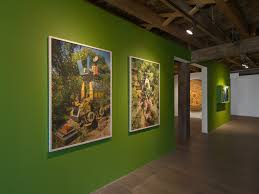By: Coco Xu
On June 22, 2024, the Storefront for Art and Architecture in Manhattan opened a very special exhibit. A hand-painted map of oil and gas wells, dredging canals, and pipelines near South Louisiana covers one wall. Another wall presents a collage of newspapers about oil mining in Louisiana and Angola from 1950 to 1975 forming the shape of a hurricane. Farther down the exhibition hall, photos of thin earth sections from a 1968 drilling mission are displayed on light boxes.
This exhibition is titled “Gulf” (pronounced “Strike Gulf”) and was created by artist Imani Jacqueline Brown. It is meant to show the negative consequences of oil drilling on her hometown, New Orleans, and on the world through a blend of science and art. “I wanted to demystify oil and gas production,” Brown said in an interview with The New York Times. “The voice you need to adopt in order to communicate this information needs to be clear, but without losing the sense of poetry.”
Brown, 36, was born in New Orleans, Louisiana. Hurricane Katrina struck when she was a teenager and forced her family out of their home. She attended Columbia University and graduated with a major in anthropology and a minor in art.
Brown has a long history of climate-related projects and activism; in 2012, she took part in Occupy Sandy, a relief effort meant to help those affected by Hurricane Sandy. In 2014, she co-founded the project Blights Out, which worked to purchase damaged properties fairly from owners and repurpose them for public use. Then in 2018, she helped organize the Fossil Free Fest, an event presenting art, food, music, movie screenings, and workshops preceding the gas company Shell’s Jazz and Heritage Festival in a protest against oil usage.
Brown’s “Gulf” connects many concepts in the oil industry, like infrastructure, as shown from the map of assets, and the power of companies, referenced by the spiral of newspapers. Gulf Oil, a company that merged with the Standard Oil of California and, along with the latter, rebranded as Chevron, had heavy presence in both Louisiana and Angola and was bombarded by international boycotts.
But it does much more than just that. The project also connects research with ancestral knowledge. Brown explained in her interview with The New York Times that the Kongo people, one of the many ethnic groups enslaved in the Middle Passage, served as a major source of inspiration for her work. The Kongo people used a circular cosmogram to symbolize the cycles of life. The horizontal axis, called the Kalunga line, represents the borderline between the spirits and the living.
“Gulf” is both a scientific and artistic masterpiece. In the current world, where climate awareness is all the more important as the globe spirals towards the tipping point, projects like “Gulf” are crucial to ensuring that such awareness is more widespread.











